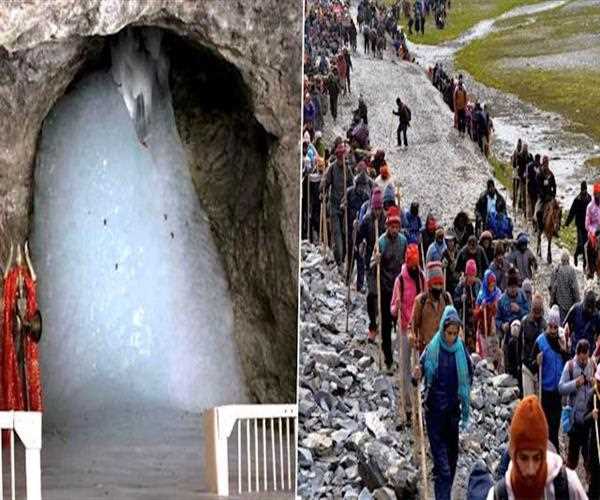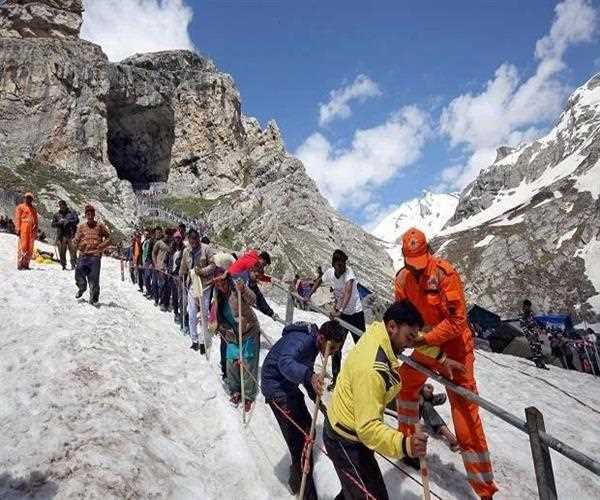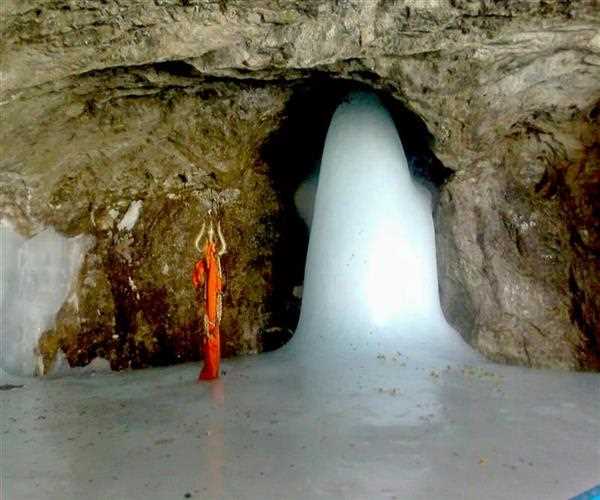Search here

01-Jul-2022
Amarnath Yatra: A Journey towards the Sacred Shrine and Tranquility
Numerous thousands of people visit the Amarnath cave in South Kashmir each year over the roughly 40 days in July and August to offer sacrifices to an ice stalagmite that is thought to represent the Hindu god Shiva. The cave's name, Amarnath, which means 'God of Eternity,' comes from the legend that Shiva told Parvati the story of eternity in this location.
It is widely accepted that visiting the Amarnath Cave on Shravan Purnima, also known as Raksha Bandhan or Rakhi Purnima and falling on the full moon day of the month of Shravan, the fifth month in the Hindu calendar, is very auspicious. It usually falls between the 15th of July and the 15th of August on the English calendar.
The annual Amarnath Yatra got underway on Thursday as a group of approximately 2,750 pilgrims departed from the base camp here for the cave shrine in the south Kashmir Himalayas that is home to the naturally formed ice-lingam. Deputy Commissioner Piyush Singla started the pilgrimage at the Nunwan base camp in Pahalgam, in the Anantnag district.
The trip, which is mostly made on foot, lasts around three days, with overnight stops made at Sheeshnag and Panchtarni.
According to Singla, all preparations have been taken to ensure a seamless 43-day journey. He continued, 'Our goal is to ensure that the pilgrims feel secure and visit the shrine calmly.'
On Wednesday, J&K Lt Governor Manoj Sinha flagged off the first group of pilgrims for the Amarnath Yatra, which starts on Thursday.
Lt. Governor Manoj Sinha signalled the departure of the batch, which included 717 pilgrims, for the North Kashmir Baltal base camp from the Bhagwati Nagar base camp on Wednesday at approximately 5.30 a.m. The second group of 5,000 pilgrims left Jammu on Wednesday and arrived at Nunwan Pahalgam base camp in South Kashmir's Anantnag district on Thursday. On Thursday, the second group of 5,700 pilgrims departed from Jammu for Amarnath.
The Amarnath Yatra 2022 starts on June 30 and ends on Shravan Purnima, which falls on August 11 and is also the Raksha Bandhan festival.
Manoj Sinha, the lieutenant governor of Jammu and Kashmir, did the 'Baba Barfani' puja on Thursday morning and prayed for everyone's peace, joy, and prosperity.
'I have full faith that the devotees travelling from all across the country to seek the heavenly blessings of Shri Amarnathji will have a safe and pleasant pilgrimage,' Sinha said following the puja.
Security personnel guarded a convoy of pilgrims as they went towards the Valley. The 14 km long Baltal route in north Kashmir and the 48 km long Pahalgam route in south Kashmir are both being guarded by hundreds of security personnel from the army, local police, and central armed police forces (CAPFs).

For the first time, authorities have equipped each pilgrim with a Radio Frequency Identification (RFID) tag so that his or her movements may be tracked for safety and security reasons.
According to officials, the Shri Amarnath Shrine Board (SASB) has also provided a provision for an online 'darshan' of the ice lingam that was developed naturally.
They claimed that because the pilgrimage is being undertaken this year after a three-year hiatus, more people than normal are anticipated to participate.
In 2019, the Yatra was called off in the middle before the Center revoked the provisions of Article 370 of the Constitution. In 2020 and 2021, the pilgrimage was postponed because of the COVID-19 pandemic. A top army official reportedly stated that this year's trip was perceived as being more dangerous.
Kashmir, known as the 'paradise on earth,' is slowly getting back to normal. By putting men and sophisticated machinery to work, the Union territory of J&K has undertaken the necessary preparations for the seamless operation of the pilgrimage to Shri Amarnath Shrine.
Ancient shrines, mosques, and temples can be found throughout the whole Kashmir Valley. Every shrine has its significance and sanctity that has been sculpted out with a mythological story behind them and are still held in high regard by all communities, regardless of caste, colour, or faith. The historic past of the valley is depicted by the ancient monuments that the Archeological Survey of India (ASI) has identified and maintained.
The pilgrimage to Shri Amarnath Shrine, which started on June 30, 2022, is undoubtedly a remarkable, daring, and difficult undertaking for the J&K Union Territory. Hindus respect the Amarnath cave is one of their most important places of worship. It is regarded as one of Lord Shiva's holy shrines. People from all over the world come to the location to do homage to Lord Shiva as they witness the development of the Shivling as ice from the cave's roof melts and falls to the ground.
Nothing more impressive than the magnificent remains of Kashmir can be considered the earliest civilization of ancient India. The remains of hundreds of temples, stupas, viharas, and various schools of thought would demonstrate how it was once a nursery of the two major Indian religions, Hinduism and Buddhism, and how these religions met and mingled with one another in the mindscape of the people. Kashmir has made a significant creative contribution to Hindu thinking, particularly in the development of the monistic philosophy of Saivism known as Trika- Sastra. And when Islam emerged in the middle of the 14th century, the valley took on its unique colour.
One of the most important Hindu Dhams (religious centres) in Kashmir Valley is Shri Amarnathji. The sacred cave is the abode of Lord Shiva. In the cave, Lord Shiva—the destroyer and protector of the absolute—is worshipped as an Ice-Lingam. This lingam has occurred naturally. Along with the Shivling, two other ice sculptures are thought to be of the Goddess Parvati and the Lord Ganesha.

Hindu mythology holds that this is the cave where Lord Shiva revealed the meaning of life and eternity to Goddess Parvati. He sacrificed all his belongings, performed the Tandav dance and entered the cave with her. He set the cave on fire to extinguish all life within to make sure no one else heard what he was saying. A pigeon, however, stayed beneath him and learned the secret to immortality. They were born and even today, devotees who visit Amarnath Temple can still witness a pair of pigeons nesting inside the cave. And because the secret of immortality was told here, hence the name Amarnath.
Shiva followers thus, take the Amarnath Yatra with true hearts and feelings and present it to Lord Shiva in a hope of a righteous living, health, prosperity, and purity from the sins. Despite being one of the most challenging pilgrimages in India and being 36 to 48 kilometres long and hard to enlighten oneself by Shiva's genuine light, families, friends, and companions are frequently seen journeying together to the Amarnath Temple in Jammu and Kashmir.

Comments
Join Our Newsletter
Subscribe to our newsletter to receive emails about new views posts, releases and updates.
Copyright 2010 - 2025 MindStick Software Pvt. Ltd. All Rights Reserved Privacy Policy | Terms & Conditions | Cookie Policy